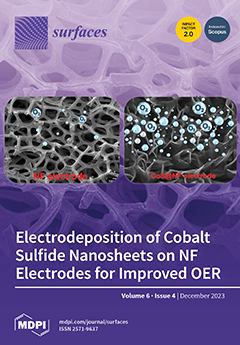The research purpose of this work is to examine the adsorption interaction of gaseous molecules (GMs), such as NO, NO
2, SO, SO
2, and SO
3, with the surface of sodium magnesium phosphate NaMgPO
4 (033), in a neutral
[...] Read more.
The research purpose of this work is to examine the adsorption interaction of gaseous molecules (GMs), such as NO, NO
2, SO, SO
2, and SO
3, with the surface of sodium magnesium phosphate NaMgPO
4 (033), in a neutral medium, using two different computational methods: density functional theory (DFT) and Monte Carlo dynamic simulation (MCDS). Various quantum and dynamic descriptors, such as global and local quantum descriptors and the radial distribution function (RDF), are also evaluated and discussed. The data obtained revealed that the NO
2 molecule has a small energy gap (0.363 eV) when compared to the other molecules, which means that it is highly reactive and is liable to adsorb, or stick, to the surface of NaMgPO
4 (033). Furthermore, this NO
2 molecule exhibits good adsorption in aqueous media, returning to the lowest global hardness value (0.1815 eV). MCDS predicted adsorption energies of −874.03, −819.94, −924.81, −876.33, and −977.71 kcal/mol for NO, NO
2, SO, SO
2, and SO
3, respectively. These energies are negative, implying that adsorption occurs spontaneously. Thus, the side views indicated which SO, NO, and SO
3 molecules are adsorbed in parallel to NaMgPO
4 and the other SO
2 and NO
2 molecules are adsorbed horizontally. Eventually, the theoretical results reveal that the studied gaseous molecules interact strongly with NaMgPO
4. The result obtained by radial distribution function (RDF) analysis for all complexes below 3.5 Å confirm that the adsorption is of the chemi1cal type.
Full article





